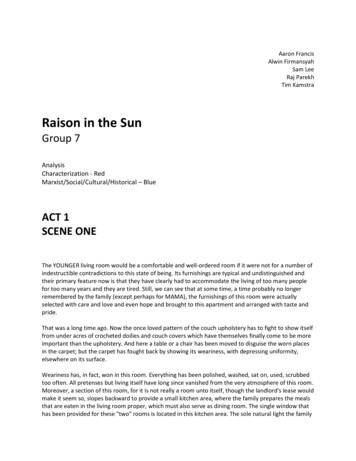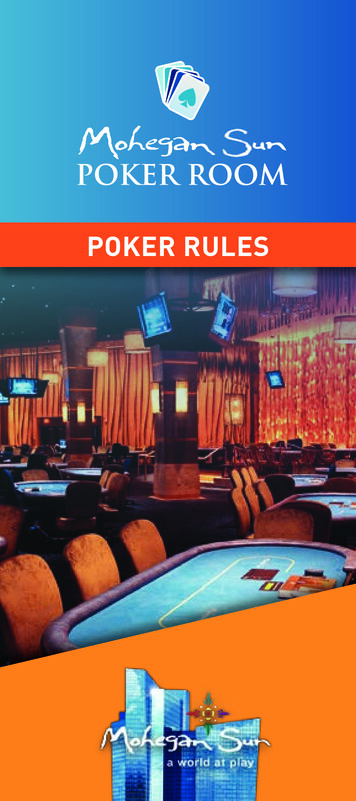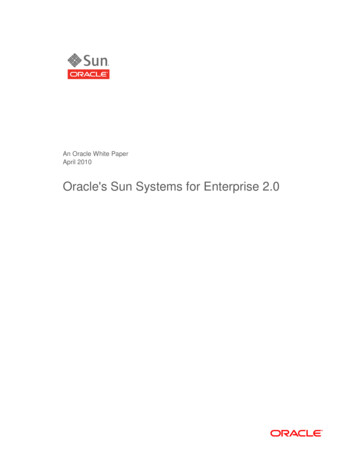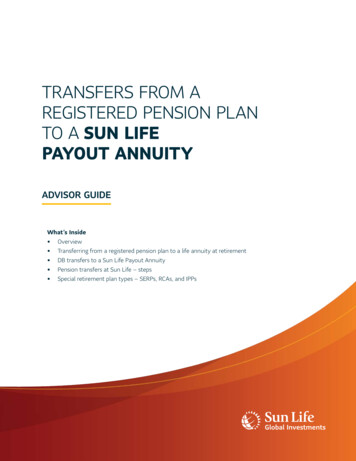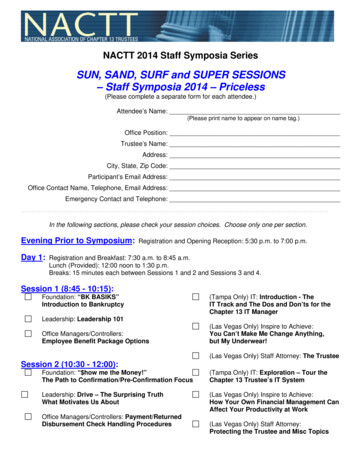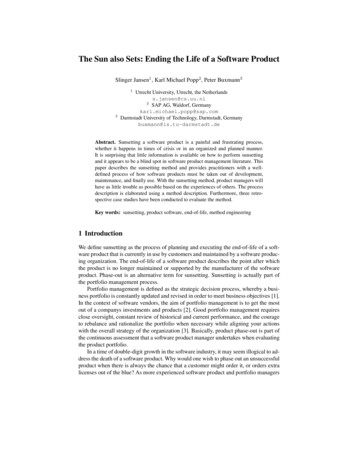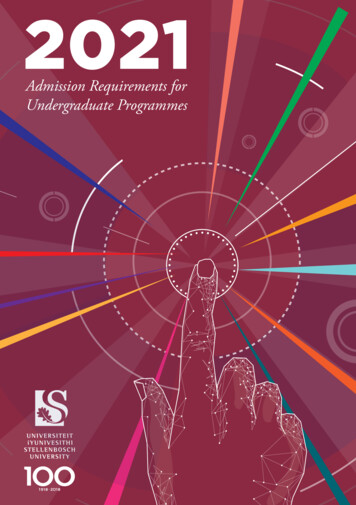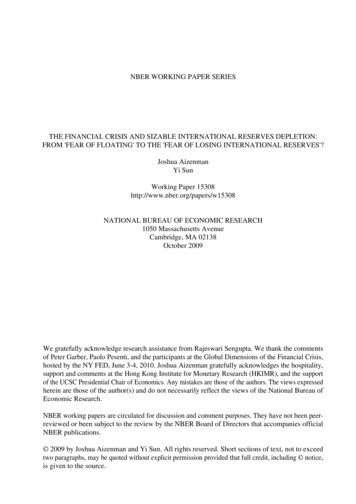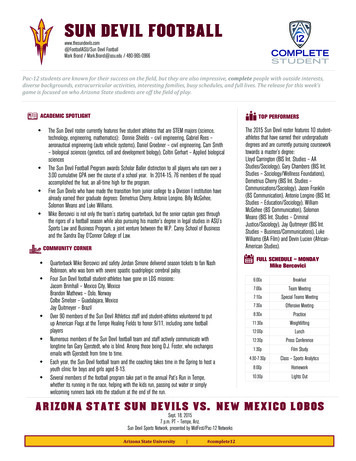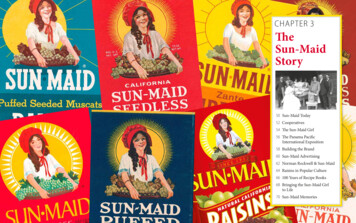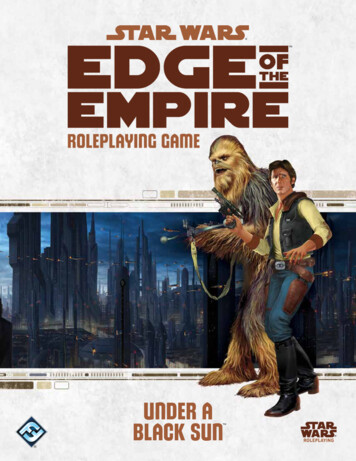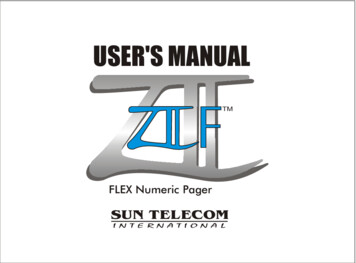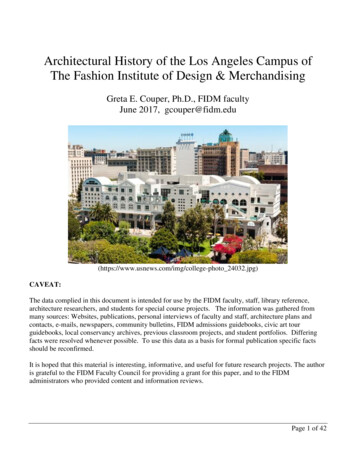
Transcription
Architectural History of the Los Angeles Campus ofThe Fashion Institute of Design & MerchandisingGreta E. Couper, Ph.D., FIDM facultyJune 2017, e-photo 24032.jpg)CAVEAT:The data complied in this document is intended for use by the FIDM faculty, staff, library reference,architecture researchers, and students for special course projects. The information was gathered frommany sources: Websites, publications, personal interviews of faculty and staff, architecture plans andcontacts, e-mails, newspapers, community bulletins, FIDM admissions guidebooks, civic art tourguidebooks, local conservancy archives, previous classroom projects, and student portfolios. Differingfacts were resolved whenever possible. To use this data as a basis for formal publication specific factsshould be reconfirmed.It is hoped that this material is interesting, informative, and useful for future research projects. The authoris grateful to the FIDM Faculty Council for providing a grant for this paper, and to the FIDMadministrators who provided content and information reviews.Page 1 of 42
Table of ContentsExecutive Summary . 3Project Description . 4History of the FIDM Campus . 4Current FIDM Los Angeles Facilities . 5Main Los Angeles Campus . 5First Floor .6Second Floor .8Third Floor .9The FIDM Library.10Fourth Floor .11Student Lounge .12Fifth Floor .14Garage Spaces .15The FIDM Museum & Galleries . 17History of Grand Hope Park . 18Art Within FIDM and Grand Hope Park. 21Renaissance Tower Space . 24The Annex (aka The Idea Center and Classrooms) . 25Hope Street Annex . 30Appendix . 33Early FIDM Advertisements . 33Architecture Dates for FIDM Locations . 34Seven Principles of Universal Ergonomic Design . 35Five Principles of Inclusive Ergonomic Design . 36Student Architectural Projects about FIDM . 37Related Videos . 38Undeveloped Plans for a New FIDM Tower . 39Works Cited . 40Page 2 of 42
Executive SummaryThis report includes architectural and historical data about the Fashion Institute of Design &Merchandising (FIDM) Los Angeles campus from its inception in 1969, to the current location. Itincludes the initial rented space in 1969, the moves to new locations as the school grew, leased locations,a list of the current buildings in use in 2017, and details of the floor plans of the main campus building onthe Grand Hope Park property. The intention is to provide easy historical access to faculty and studentsfor class projects. In addition to the Main Campus which opened in 1990, this paper contains brief noteson the development of the leased Annex (1926 Standard Oil Building) classrooms, the Park Annex(Renaissance Building) classrooms, the Hope Street Annex, and the Jewelry Design & Studio. Details ofthe architects and furnishings are included when available. It is important to have this material in oneplace, especially as many of the architects and designers have changed jobs, and archived material is instorage and not always available. The data in this report is intended to be used by faculty and students inclasses that want to evaluate the physical configuration of the FIDM campus, from a historical, design,and ergonomic viewpoint. It is hoped this data will be useful as a teaching tool for classes. Theinformation can be used to offer students an opportunity to apply their study material directly to thedesign of the school, and support them with needed facts.The Fashion Institute of Design & Merchandising was founded in Los Angeles in August 1969 byvisionary Tonian Hohberg, for both men and women to study fashion and merchandising. FIDM wascreated in direct response to the growing needs of the fashion industry in California. In the late 1950s,sportswear apparel manufacturing and the entertainment industry were well established in California, thesecond largest fashion and apparel area in the United States, following New York. Concentrating oncasual wear and notable sportswear labels, it gained additional importance to the movie industry andcostume designers. Once fashion designers relocated to this area, clothing manufacturers followed. LosAngeles was the ideal location for a West Coast fashion and merchandising college.From the beginning, FIDM's mission was to build strong industry relationships in order to benefitthe students, colleagues in the industry, and the college. The original campus was strategically placed inthe garment district in downtown Los Angeles on 8th Street, in a small facility close to the majordepartment stores of the time -- across the street from the flagship May Company headquarters, and justblocks from Broadway and Bullocks. Early partnerships were created with these major department stores,and students were given internship roles. The school built excellent relationships with both industry andcommunity leaders, whose partnerships helped the campus to grow. This kept FIDM up-to-date onchanging trends and community needs, and the curriculum continued to stay ahead of the competition.President Hohberg continues to create alliances with top influencers. She established a strong friendshipwith Los Angeles Mayor Tom Bradley in the 1980s who helped encourage her to establish FIDM in SouthPark, a somewhat neglected area of the city that needed growth and change. In 1990 FIDM became a newlandmark there on Grand Avenue, a beacon and magnet for other businesses to move to the area, andprovided a huge positive influence to what was a neglected part of the city.When the college opened in 1969 it had a small teaching staff who educated a student body of 24.By 2016 there were over 5,300 students actively enrolled, with new degrees being added. The collegeoffers a master’s, bachelor's, and associate degree programs in 26 majors. Distance learning courses arealso available online. With a loyal faculty of over 300 strong FIDM remains dedicated to preparingleaders in the global industries of fashion, visual arts, interior design, and entertainment. When studentsgraduate they go on to rewarding careers in fashion and business, including designing gowns for redcarpet celebrities; creating television, movie sets, costumes, and posters; launching their own companies;and working as fashion buyers, graphic design, digital art, product development, interior design,marketing experts, footwear design, and related industries.Page 3 of 42
Project DescriptionThe “Architectural History of the Los Angeles Campus of FIDM” includes data from its inceptionin 1969, to the current location. The project was inspired by an assignment that I gave to my HumanFactors in Design class (GNST2080, Winter 2017) to analyze the ergonomic space of the 4th floorStudent Lounge. When I discovered that little material was easily available, and students had noknowledge of the architects and designers for the lounge and furnishings, this became a mission. Becausethe overall design of the FIDM Los Angeles campus is very unique, it is important to have this materialavailable for future research projects and student exploration in many aspects of art, aesthetics,ergonomics, architecture, history, community development, and space functionality.This document includes current floor plans, some furnishings, and links to functional designstudent projects of the FIDM Los Angeles main campus, as well as interview content from peopleinvolved with the project, the budgets, architectural plans, and data from historical newspapers andpublications. The intent is to allow future FIDM classes to use their specific course skills to analyzeaspects of the campus, and also to have this material easily available for access in the FIDM library.History of the FIDM CampusThe Fashion Institute of Design & Merchandising was established by CEO Tonian Hohberg inMay of 1969. It began with 24 students and 3 faculty members in a rented office space at 323 W. 8thStreet, Los Angeles, in the heart of the Fashion District, across from the flagship May Companydepartment store. The original name of the school was the Fashion Institute of California (FIC), whichchanged in November 1970 to the Fashion Institute of Design & Merchandising (FIDM). The othernearby fashion education school competitor in this area was the California Fashion Institute, locatedaround the corner at 818 S. Broadway, run by designer Jack Handford, which began in 1962. He laterestablished the Fullerton College fashion design program and the Otis Art School fashion design program.Thus, it was important to have a more distinguishable name, and include merchandising in the curriculum.In addition to classroom education, FIDM produces annual fashion shows of student work. Thefirst three shows were held at the California Mart. Shortly thereafter, the show was transformed into afundraiser for the FIDM Scholarship Foundation, and took place at venues like the Biltmore andBonaventure hotels, and the Promenade Mall in Woodland Hills. In 1980 the annual show became knownas the Fashion Debut. Recently debuts are held in the Santa Monica airport Barker Hanger.From a small beginning in 1969 the college grew rapidly and in 1973, a new branch campus wasestablished in San Francisco to meet the needs of students and the emerging fashion industry in NorthernCalifornia, which included retail giants Levi Strauss and the GAP. FIDM expanded quickly and in 1977moved to a 40,000 sq. ft. facility at 818 W. 7th Street in Los Angeles. This held 1,400 students and 150teachers. In addition to Los Angeles, FIDM now had branches in San Francisco and Sherman Oaks(Gindick, Tia). This move was accomplished with assistance from the Los Angeles CommunityRedevelopment Agency (CRA) in attempts to resolve a shortage of office space in the downtown areathrough different companies sharing a building (Kinchen, David). In 1979 FIDM added another 27,000 sqft of space at 9th and Figueroa, and now had a total of 66,000 sq. ft., sharing the 12 story building withBarker Bros. and Pacific Telephone (LA Times, Jan 14, 1979). The entire southern California region wasbecoming a major retail center and a campus in Orange County was added in July 1981, and another inSan Diego in July 1985. By 1983 enrollment had reached 3,000 students (LA Times, 1983).Page 4 of 42
Tom Bradley, then Mayor of Los Angeles, encouraged CEO Hohberg to establish FIDM in SouthPark, adjacent to the proposed new Grand Hope Park. In 1990, FIDM became a new landmark on GrandAvenue, beckoning other businesses to the area, and remains the location for the Los Angeles campus. In1993 the Grand Hope Park was finally completed, and FIDM then leased classrooms in the nearbyRenaissance Tower and Olympic Annex, which consolidated FIDM’s Los Angeles facilities. Additionalclassrooms were later added at the Hope St. Annex and in the Jewelry District as enrollment grew.Current FIDM Los Angeles FacilitiesThe Fashion Institute of Design & Merchandising, (FIDM), main Los Angeles campus, wasdesigned by the Jerde Partnership (Jon Jerde, 1941-2015), Venice, CA, and developed by the RatkovitchCo. (Wayne Ratkovich), Los Angeles, CA, and built alongside the then proposed Grand Hope Parkcomplex. David Gazek was the Ratkovitch project manager. Completed in 1990, FIDM contains 200,000square feet: Five floors at ground level and above, and three floors of underground parking.Later leased buildings were added and redesigned by the innovative Clive Wilkinson Architecture firm(CWa). The extended Los Angeles complex consists of the following facilities (details discussed later): The Main Campus Building & parking, 919 S. Grand Avenue, Los Angeles, CA 90015The Annex (1926 Standard Oil Building) leased at 605 W. Olympic Blvd. , Los Angeles, CA 90015The Hope Street Annex leased at 800 S. Hope Street , Los Angeles, CA 90015The Park Annex (Renaissance Tower) leased at 501 W. Olympic Blvd. Los Angeles, CA 90015The Jewelry Design Studio leased at 640 S. Hill Street, Plaza 3, Suite 754, Los Angeles, CA 90014FIDM is an accredited, coeducational, specialized, proprietary college with campuses in LosAngeles, San Francisco, San Diego and Orange County, California. Throughout the year, FIDM hostsnumerous events and exhibitions, including fashion shows, costume exhibits and fashion industry events.In addition to its presence as an internationally renowned fashion, design and merchandising institute,FIDM helps manage Grand Hope Park (located directly adjacent to FIDM’s main campus on GrandAvenue, and supports the community-related events occurring there.Videos of the FIDM campuses are available as follows: Four Campuses: http://www.clivewilkinson.com/portfolio page/fidm-los-angeles/ Tour of the Los Angeles Campus: https://vimeo.com/201041858 FIDM Overview: http://fidm.edu/en/about/fidm video gallery Jewelry Design Studio: https://www.youtube.com/watch?v c0JqWhZYA2U Textile Design Program: https://www.youtube.com/watch?v Kwnr4B0scmkMain Los Angeles CampusFIDM Los Angeles has additional classrooms and workspaces in historic buildings in the Fashionand Jewelry Districts in downtown Los Angeles- close to the main campus. The main campus building islocated at 919 S. Grand Avenue, and consists of five floors: One with public access and retail and displayspace; one with administrative offices and conference rooms, and three with classrooms and studentservices areas. These are defined in greater detail under each section below. In addition there are threeunderground parking levels, making the campus eight floors in total. FIDM owns the property that thecampus is built on, and the City of Los Angeles owns the remaining Grand Hope Park property.Page 5 of 42
(Photo: .html)First FloorThe first floor consists of the public open rotunda entry with art work, the Security Desk, the FIDMBookstore, the FIDM Café, the FIDM Museum and gift shop, the Scholarship Store, the broadcast DigitalMedia Center, and the special collections FIDM Gallery. The art work in the Rotunda and within FIDMis owned by the school, and is discussed in the “Art in Rotunda” chapter below.Page 6 of 42
(Rotunda Photos: G. Couper)Page 7 of 42
Second FloorThe second floor consists of the main lobby Reception, the Executive and Administrative Offices,conference rooms, the Career Center, the Perfume Museum, Public Communication, and Admissions.(Photo: G. Couper)Page 8 of 42
Third FloorThe third floor consists of the Library, Faculty Mail Room (316), Faculty/Staff lounge (318), FacultyLockers (317), College Services and Supplies (315), and classrooms.(Faculty Lounge, Photo: G. Couper)(Library: dy-spots-at-fidm-los-angeles)Page 9 of 42
The FIDM LibraryThe library was funded in 1975 and is the largest specialized collection for fashion in the West Coast. Ithouses books, magazines, brochures, newspapers, a clipping file, trend forecast reports, media materials,and other design related sources. In addition to printed materials it has access to international onlinesources, interlibrary loans, and a large multimedia, slides, and audiovisual collection. The CDs, DVDs,and slides include subjects from architecture to business management; interviews with importantdesigners, and historical runway shows.Separate rooms within the library hold special collections, including rare materials, photographs, andsketches from the late 1800s to current items. The textile and materials collection has a research databaseand over 6,500 examples of innovative and sustainable materials. Also provided are Trend Forecasts andSeasonal Reports in color, fabric, and design concepts up to 18 months in advance of each season.The Visionaire collection provides a unique multi-format series about fashion and art.Page 10 of 42
Fourth FloorThe fourth floor consists of the Registrar Office, Student Lounge, Student Activities (425), FinancialServices, Cashier (402), eLearning (403), Counseling Offices, Information Technology (408), andComputer Labs.(Photo: Mark Jaress, FIDM Publications)Page 11 of 42
Student Lounge(Photo: K. Odman)(Photo: K. Odman)The chairs were provided by Segis America,New Jersey, and were made in Taiwan.Average Student Measurements Sitting Height (floor to back of knee) – 16” Shoulder Height* - 22” Elbow Height* - 9.75” Thigh Height – 21.25” Hip Width – 13.25” Shoulder Width - 15.25” ChairMeasurements:Seat Height: 18”Back Height: 32”Seat Depth: 15”Seat Width: 16”Back Width: 12”Knee Height - 20.5”The tables were provided West Coast Industries, of San Francisco, and called “Basic Round”, foundonline at in
offers a master’s, bachelor's, and associate degree programs in 26 majors. Distance learning courses are also available online. With a loyal faculty of over 300 strong FIDM remains dedicated to preparing leaders in the global industries of fashion, visua
